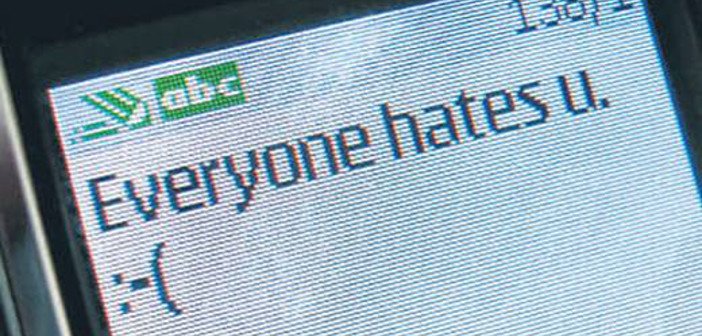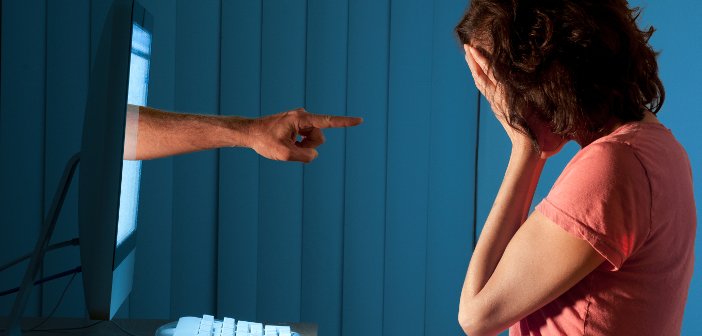Not All Faceless Cyberbullies Are Fourteen Year Old Trolls Who Don’t Know Any Better
This particular piece on cyberbullying has been in the works ever since I decided to let loose writing about mental health. A few weeks ago, after seeing One Direction fans target Loose Women panelist Saira Khan – simply because she tweeted Harry Styles after passing him in a hallway – I decided it was time to talk about it.

For years, anti-bullying charters have been stationed on the walls of schools where conventional bullying is most likely to happen. For bullied children and adolescents, it is often hoped that conventional bullying – name calling, exclusion, hitting, pinching, shoving, abusive language, threats, damage to property or possessions, and anything else repetitive that a person could place on this non-exhaustive list of ways we torment one another – will cease when the school bell rings. However, a study in 2014 revealed that 43% of kids had been victims of cyberbullying.
So why is this the case?
It appears that individuals who engage in cyberbullying firmly believe that there are no associated real-world consequences. Indeed, the separate term ‘cyberbullying’ is often portrayed in media campaigns as the sending of cruel texts or online messages. They rarely seem to drive home the actual meaning, or the subsequent effects.

A cyberbully is defined as “a person who uses repeated inappropriate behaviour, strength or influence, whether directly or indirectly, verbal, physical or otherwise to intimidate, torment, threaten, harass or embarrass others.” However, cyberbullying isn’t as clear-cut as it sounds. The tirades of abuse received by Khan a few weeks back only serve to highlight a very specific, identifiable type of cyberbullying. It is by no means pleasant, or something anyone should have to put up with, but cyberbullying is often not so easily discernible.[pullquote]The separate term ‘cyberbullying’ is often portrayed as the sending of cruel texts or online messages. The media rarely seems to drive home the actual meaning, or the subsequent effects.[/pullquote]
We all remember ‘Slane Girl.’ We all remember seeing a photo of this underage girl plastered all over Facebook and Twitter. We all remember the condemning comments beneath this photo, all the friends tagged, all the times the photo was shared, liked, distributed, until it was seen by everyone.
Maybe you were one of those people.
Maybe you were unaware that for every single engagement you had with that photo, you were guilty of cyberbullying too. Maybe you are presently unaware that every time you like or share an embarrassing photo or video of someone – whether that be a friend or a total stranger – you are cyberbullying. The ‘repetition’ element of the cyberbullying definition extends to more than just an individual repeatedly sharing, liking or otherwise causing an image or video to be seen by others. It ,instead, encompasses every single person engaging with it.

That calls into question the reasons why people cyberbully. In the case of direct, clear-cut cyberbullying, it’s often borne from frustration, anger – or in Khan’s case – jealousy. Regarding mass-shared imagery or videos, it could be interpreted as crass entertainment, or just plain ignorance.[pullquote]The distance between the bully and the victim is often perceived as being so large, that the potential impact of the bully’s words or actions is not fully comprehended.[/pullquote]
In the case of ‘Slane Girl,’ there were definite misogynistic undertones to the entire debacle, as very few people commented on the boy in the photographs’ involvement in the scenario. In that sense, then, it is extremely difficult to understand the complexities of cyberbullying, or why people engage in it. Most notably, the distance between the bully and the victim is often perceived as being so large, that the potential impact of the bully’s words or actions is not fully comprehended.
So what does all of this have to do with mental health?
Well, another study conducted in 2014 showed that kids are 2 to 9 times more likely to attempt suicide due to cyberbullying. Let that number sink in. Just like any other form of bullying, cyberbullying causes emotional, physical and psychological distress. According to evidence gathered by StopBullying.gov, kids who are cyberbullying victims are more likely to develop depression or anxiety. This can not only have a major impact on school performance, but could also lead to future drug or alcohol dependency.

The shocking reality is that most research done on cyberbullying pertains directly to children and adolescents. Adult cyberbullying activity is often grossly overlooked. A fact that is quite worrying considering that in the case of Slane Girl, and the many other cyberbullying victims we may have heard about through the media, the majority of perpetrators were adults.[pullquote]When we look at persistent trolling online, it is no longer safe to assume that every faceless profile is a fourteen year old boy who doesn’t know any better.[/pullquote]
Indeed, when we look at persistent trolling online, it is no longer safe to assume that every faceless profile is a fourteen year old boy who doesn’t know any better. One may be better off assuming that the person behind the profile is a fully grown adult, aware of what they are doing but confident that they will suffer no consequences. This is where the bullies are wrong.
Last April, a bill was proposed to ensure that cyberbullies would be smacked with a fine, or jail time. Even with the current absence of a specific cyberbullying law, harassment via technology is classed under the Non-Fatal Offences Against the Person Act 1997, especially if there are grounds to prove that there was an intention to inflict emotional distress. What that means is, in the case of ‘Slane Girl,’ or any other ‘funny’ – or rather, ‘cruel’ and ‘malicious’ – video or photograph that you may see circulating around the internet, the person who initially posted it would be liable for conviction.

So really, it’s simple. If you see a photo of someone in a compromising, embarrassing, or upsetting situation – don’t share it. Report it to the administrators of whatever platform you’re using. Facebook and Twitter both have very explicitly clear guidelines and will have the images taken down within a very short space of time.
And above all else, try to humanise the situation. If it was you, I can guarantee you wouldn’t like to have that photo posted online. It doesn’t matter what the person is doing or what assumptions you make about that person’s character based on the image. Cyberbullying is never an excusable action. Make the active choice to not partake in it. There are so many things wrong in this wicked little world, and those of us embroiled in the world of social media would be better off with one less thing to worry about.
